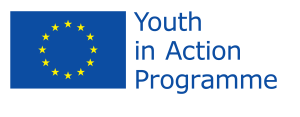Updated on September 1, 2022
One day in the collection of olives with project M.A.R.E and M.A.R.E supporting team
On the 6th of October, two days before the departure of the volunteers of the supporting team, the president of the marine park, Lucio, invited us to live the experience of the olive collection at the house of his step family. Traditionally in Italy, the collection of the olives starts the first day of November, the day of the dead, and is done by hand. Of course, it can start earlier and can go up to December, but it’s normally in November that is associated the olive cultivation, a ritual that started almost 6000 years ago. Olives are collected directly from the tree and then, starts a race against the clock. From the time when olives are collected starts the oxidation of the fruit and they have to be taken to extract the oil as fast as possible. Olive oil is a raw material as important as it is delicate and it’s very important to identify the good moment to collect them. The olive harvest in Italy is also an important social occasion as families come together to pick the olives and press them for the first extra virgin olive oil. This makes it possible to harvest the greatest number of olives per tree and obtain maximum oil yield, while maintaining quality levels. Normally, 100 kg of olives yield 16 to 18 kg of oil.
It was a very powerful feeling to be invited in this house and be part of what is a very old family tradition. We arrived in the morning and were welcomed with the traditional Italian “cornetto” and caffé. After exchanging salutations, we went straight to work, we split in different teams and covered the hole property to harvest the olives. Working with olives required a lot of patience because the collect is done by hand, branch by branch, and when the harvest is over it’s very important to check and remove the olives that are already bad. All of the volunteers worked for few hours and we harvested kilos and kilos of olives. At some point during the work, we started smelling the nice smell of the pizza oven working… What was our surprise when we realized that Lucio’s step-father prepared more than forty pizza dough for us! While the pizzas were getting prepared, we sat to have some drinks all together and after some time the first pizzas started to arrive! I have been living in Italy for 6 months and I have tried a lot of pizzas during this time but I can say without any hesitation that the pizza we had that day were the best I had ever tried in my life. Simple margherita, only with tomato sauce, mozzarella, basil and a bit of oil… mind blowing!!! We ate all the pizzas we could eat that day and when everyone was full of pizza and drinks, they offered to make our own pizzas with the remaining dough. Each one of us that wanted to try, made their own pizzas. We started by working out the dough, slowly, using a lot of flour. Then we had to flatten the dough to make our pizza, added tomato sauce, cheese and directly in the oven! 5 min later… et voilà! A beautiful pizza. It was an amazing experience to be able to be so close to the Italian culture! The afternoon went on with pizza, drinks and dancing. I can say surely that everyone had a lot of fun that day. Around 5pm it started pouring rain and everyone was invited to go inside the house to stay dry. One by one we started to run towards the house until one of the volunteers, Arthur, arrived in front of the door and fell majestically because of the slippery floor! The crazy laugh we all had when we realized that there were cameras around and that we could see that fall over and over again (don’t worry nothing happened to him, he was perfectly fine). This beautiful day ended with the kindness of these people who, in the end, gave us a ride home so we won’t be soaked wet walking back.
During this day we all put ourselves to work, we met great people and learnt a lot. We got closer to the Italian culture and shared a bit of our own. Thanks to this great team we worked while having fun which made things quite easy in the end. It was a great way to enjoy one of the last days of the volunteers of the supporting team, I think I can say without a doubt that we are all thankful for the opportunities that give us this project. I will always remember that day of my life when I picked up the olives and made Italian pizza for the first time, I will cherish every memory that I made with this team. Thank you all.

Updated on August 27, 2022
Cigarette Butts – a dangerous waste for marine life
While the consequences of consuming tabacco on human health are widely known, the environmental damages caused by cigarette butts thrown away in nature are rarely addressed. As cigarette butts are not biodegradable, they pile up in vast amounts in our oceans. Did you know for example that 98% of cigarette filters are made out of plastic fibers?1 With more than 4.5 trillion butts littered each year, according to National Geographic, they are even attributed one of the biggest man-made ocean contaminants worldwide.
When cigarettes are smoked, burnt and left, they do not simply represent a littering problem. This is because conventional cigarette filters contain up to 4000 chemicals and heavy metals. These substances after smoking remain in the butts and turn into toxic and dangerous waste, such as lead, nicotine and arsenic (arsenic is naturally component of the earth’s crust, however in its inorganic form arsenic is highly toxic2, and was used e.g. in rat poisoning3). As such, they can be a severe danger for small marine animals and can even destabilize entire ecosystems.
This effect of cigarette butt pollution on marine life is demonstrated in many scientific experiments. As researchers at the University of San Diego under the lead of Prof. Thomas Novotny, found out, fish exposed to the amount of nicotine represented in 1 cigarette butt and dissolved in 1 liter of water can kill them after only 4 days. With nicotine, fish begin to shake, turn upside down and finally sink to the ground. Some toxins can even accumulate in certain fish, such as the trout, and thus remain in the food chain of the ecosystem for longer time.4
So what can you do against cigarettes pollution in the ocean?
- Reduce your impact. Dispose cigarette butts responsibly. Take a bag or portable ash tray with you on the beach.
- Participate in Cleanups – Cigarette butts are the item mostly recovered at cleanups. Tell your peers about the problem.

Did you know that cigarette butts can even be recycled. The initiative TobaCycle collects cigarette ends through restaurants, bars and companies and utilize the recycled plastics from the filters to produce new products such as recycled cups and ashtrays. This means less waste; less pollution and materials are kept in the cycle5.
by Julia Pfeiffer
Sources:
1) National Geographic (2021): https://www.nationalgeographic.com/environment/article/cigarettes-story-of-plastic Tania Velin, Kelsey Nowakowski. Sources: Bradford Harris, Tobacco Control, 2011 ; Viceroy;Truth Initiative; Terracycle; 5 Gyres Institute
2) WHO (2021): Arsenic. https://www.who.int/news-room/fact-sheets/detail/arsenic
3) California Against Litter (2020): Cigarette Litter. https://www.cawrecycles.org/cigarette-litter
4) Slaughter E, Gersberg RM, Watanabe K, Rudolph J, Stransky C, Novotny TE. Toxicity of cigarette butts, and their chemical components, to marine and freshwater fish. Tob Control. 2011 May;20 Suppl 1(Suppl_1):i25-9. doi: 10.1136/tc.2010.040170
5) ZDF Heute (2019): Umweltproblem Zigarettenkippen, https://www.zdf.de/nachrichten/heute-in-deutschland/umweltproblem-mit-zigarettenkippen-100.html
Updated on August 27, 2022
“LOOKING FOR A CARETTA I REMOVE MY ‘CARETA’ ” -Ignacio
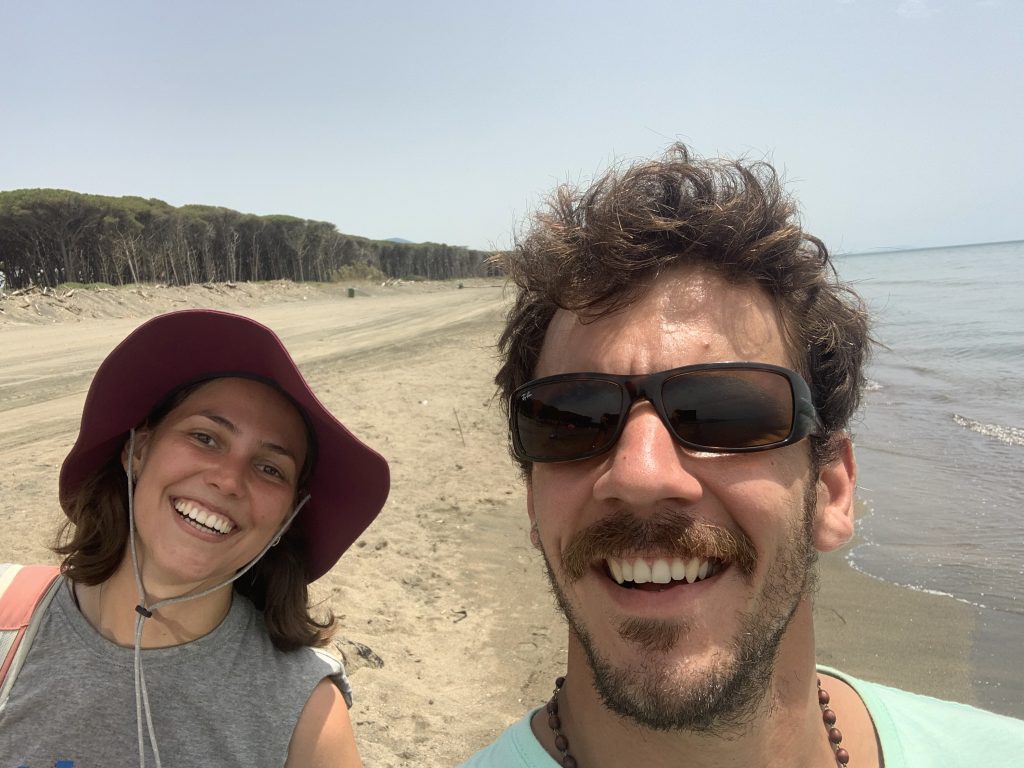
Fortunately, this beautiful coastline is increasingly frequented by the Caretta, a species in danger of extinction. The sad side of the story is that the turtle on many occasions needs human help so that the nest can move forward because sometimes the eggs are deposited too close to the sea or, on the contrary, it is threatened by human activities on the beach that prevent a continuity of Caretta’s offspring.
This experience for me has been a great learning experience that I must thank Lido Azzurro (Baia Felice), the great Erica Moura (AMP Punta Campanella), the Anton Dorhn Zoological Station, the Domizia Group and Marcello Giannotti (ARDEA). These entities are putting effort and commitment to preserve the biodiversity of the area and specifically to save the Caretta Caretta.
Our work in Baia Domizia consists of searching for signs of Caretta nests whose tracks in the sand are similar to tracks of tractor. This is ironic because in our search the tractors are an element of confusion or even cancellation of the track and the nest, and unevenness in the sand in the shape of a crater: the possible nest. In case of being lucky and finding a real nest, the possibility of changing its situation should be evaluated, generally moving it away from the tidal line and placing it above the storm line, an environment identical to the nest produced by the mother should be generated in terms of to characteristics of the sand and also once the new nest is buried, a net of about 1×1 m must be inserted to prevent other excavating species from finding the nest, endangering the eggs.
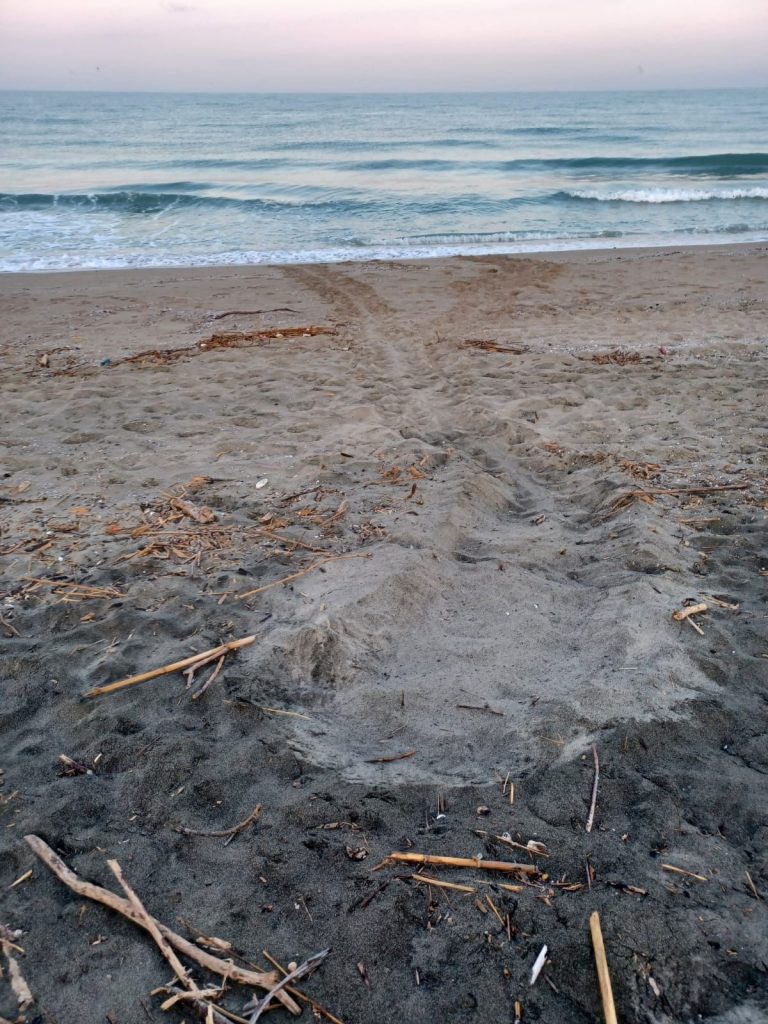
This is undoubtedly the most exciting and rewarding part of a very tiring job such as traveling miles and miles of beach under the sun. But it doesn’t end here. Our work in addition to patrolling is communication and awareness with the managers of the Lidos that are so present on this coast; This dialogue is developing and the objective is to find a balance between our moral responsibility with the protected species and the unconditional search to obtain a monetary benefit from the beach. During the afternoons, meetings have been held with said beach owners and workers to share identification knowledge and modes of action in case of finding a footprint or a possible nest. We have also had the opportunity to get closer to the little ones in a meeting to raise awareness and knowledge about protected species that nest on the beach such as the Caretta, the Frattino and the Corriere Piccolo, the last two taught by great professionals and people Marcello Giannotti and Giovanni from the ARDEA association.
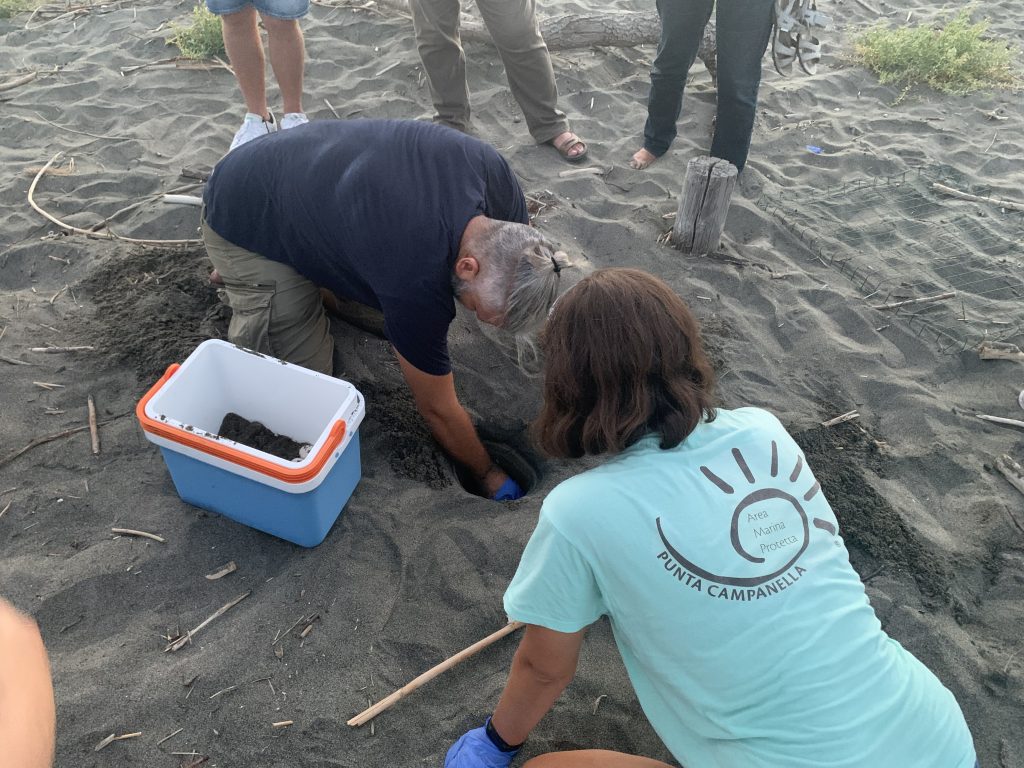
As an isolated event, one of the saddest moments that touched my heart happened on my first morning on patrol on the beach when Ali (Project M.A.R.E) and I found a dead turtle on Il Lido Beach. The turtle had a large cut in the shell probably caused by the propeller of a boat. Without knowing the intention or the degree of guilt of this boat we can affirm that they did not bother to notify the Coast Guard and that unfortunately almost every day turtles are found in a state of difficulty, all due to direct or indirect actions of the “human” being.
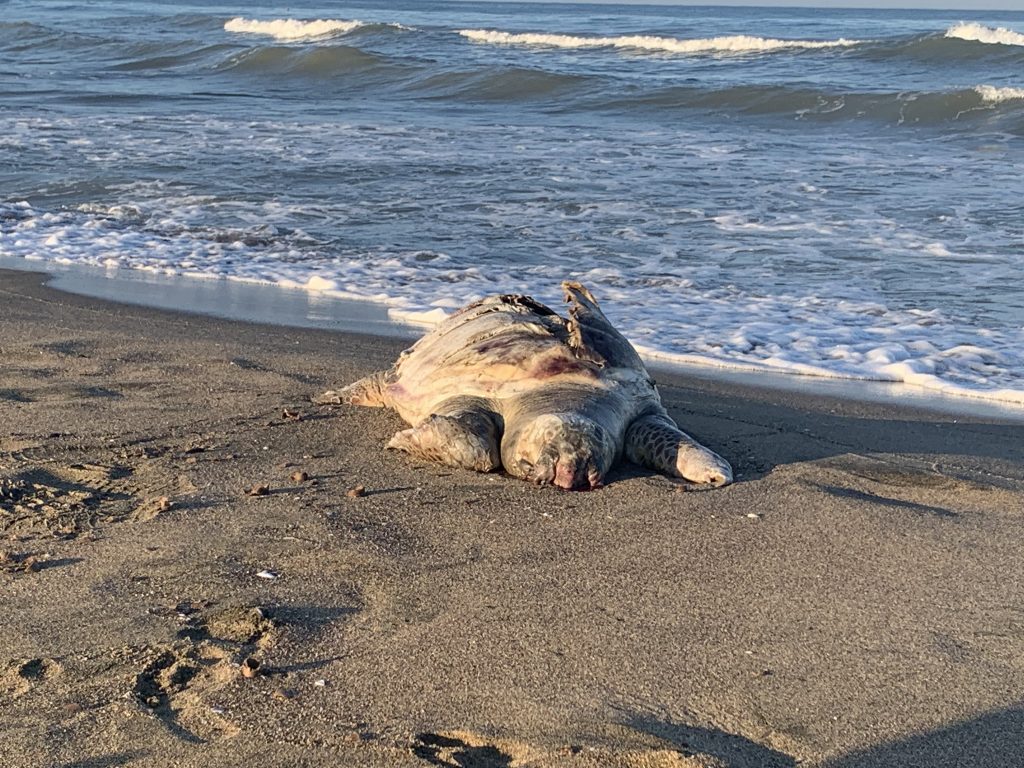
Trying to see the glass half full and at the level of tangible objectives, I can proudly say that I have participated in the work carried out in 4 Caretta Caretta nests found in the Castel Volturno area, contributing to the continuity of an amazing and terribly threatened species, having spreading a message of hope with people of all ages is something that could never have imagined 3 months ago in Madrid.
Updated on August 27, 2022
Mafaldas Cilento experience
This year we started on the 15th of June, because from the records of last year, the first nest that was spotted in Cilento was approximately on the 12th.
Finally the day arrived, I was feeling excited to go to a different kind of environment, meet new people and give my best contribution to the Caretta caretta monitoring. I was not sure what to expect and I was also thinking how it would feel to leave Massa Lubrense and my mates from Project M.A.R.E. for a whole week..
Before my departure, our project coordinator gave us a heads up on where exactly was the area of Cilento and how many sandy beaches in englobes, but I had no idea that the coastline was so extensive as 100 km. Cilento is a province of Campania located on the Tyrrhenian sea, from the ancient greek city- Paestum to the gulf of Policastro. Since i was chosen to be the first one to go, I couldn’t imagine how it would be, how to get there, where we will sleep, what kind of activities we will do besides the beach monitoring and so on.

Actually, the way from Massa Lubrense to Camping Le Saline in Palinuro, which was the place I was living for one week, it’s not so complicated- 1 bus and 2 trains to catch.
The moment I arrived, I went straightly to put my things in the tent and went to the beach at 6pm with my friend, the supervisor of the Monitoring in Cilento. I met her during the past 2 months in Massa and we got along pretty nicely, she is also from Portugal and had already participated in Project M.A.R.E edition of 2018. At night we went to the center, to meet some friends from the camping that she made 2 days before I arrived and we had a great time- talking quite a lot in Italian and eating a Singaro (typical pizza shaped in a roll). So, during the first week there were no other volunteers. For 2 days, we were hanging out with them, otherwise it would just be me and my friend.
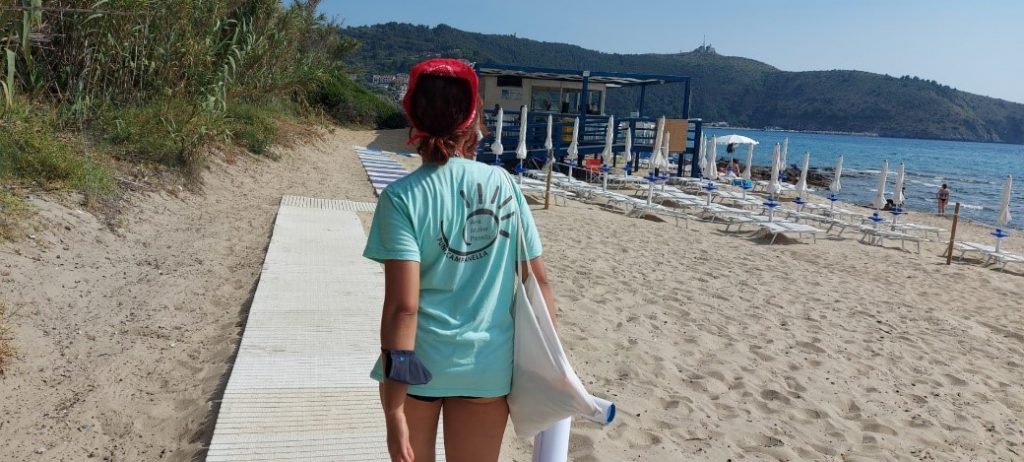
The next day we woke up at 5:30, and got ready to go down to the beach and start our first monitoring to look for the presence and traces of the marine turtle Caretta Caretta. During the whole week we had more or less the same routine, waking up at 5am, going to the beach and do the monitoring till 8am, come back to the camping and have breakfast, rest and go again to give flyers to the beach bars about the marine turtle nesting season and also to enjoy the biodiversity of Palinuro’s beach by snorkeling.
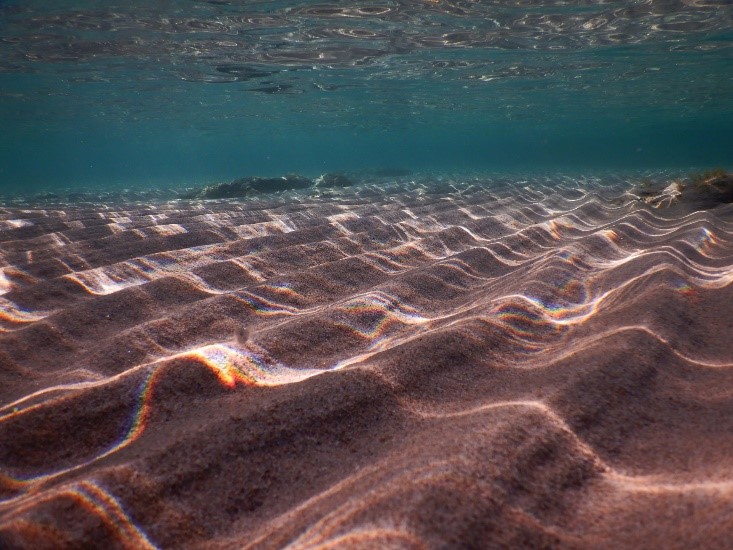
In my experience I didn’t find any nests. I was only monitoring beaches in Palinuro and Marina di Camerota, and we didn’t find any traces for one week, but in the meantime, other volunteers from different organizations were monitoring the beach in Ascea and they found 3 nests almost consecutively.
Depending on the day, we would walk more or less for 6 km in each beach, because from time to time we would need to monitor in Palinuro and then Marina di Camerota taking the electric bike. When they found nests in Ascea after our busy mornings, we would have to go there in a record time, either by bus or a random ride.
The days that the first two nests were found in Ascea, we joined the volunteers that were there guarding the traces and the nest from being stepped on by people on the beach. Once the authorized people to handle protected species arrived, from the Zoological station Anton Dohrn, we began to follow the procedure.
From what i know, we need to restrain the area first of all, then use a mazzarella to check for the density of the sand in different spots of the body pit to find the location of the eggs, then start digging gently with your hands in a way that we don’t damage them, and if we find them, the first one we need to remove from the nest, take out its content and put the Shell in an alcohol-filled tube to preserve the sample for DNA extraction, usually using 96% etanol; measure the distances from the nest to the shoreline, the dunes and possibly other variants; measure the distance from the first egg we found to the Surface, introduce a sensor to monitorize the temperature and cover back again the nest, check the coordinates of the nest and register them; collected a sand sample approximately 50 cm aside from the location of the eggs, and 30 cm Deep, using a sampling tube. Finally we put a squared metal protection with holes above the nest, digging a trench around it and camouflaging it with sand; the last part just consists of restraining the nest with wooden stakes and rope, with a warning board about Caretta caretta nest.
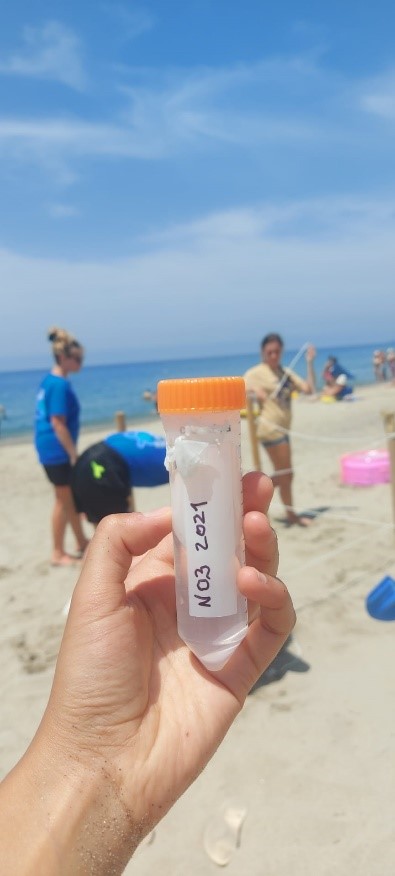
Despite not finding a nest myself I was able to experience the process, meet new people and fall in Love with Cilento during this amazing week.
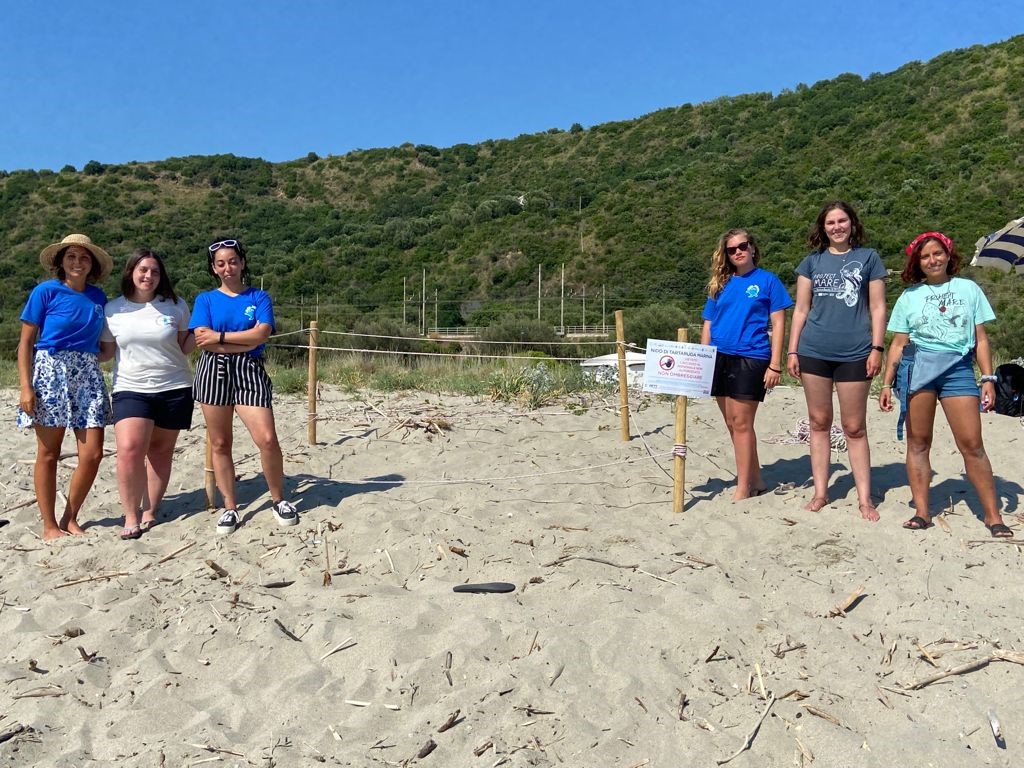
Updated on August 27, 2022
First day in Baia di Ieranto
So far we have spent almost a month in Ieranto. Working all of the June weekends there, getting to know more and more of our summer activities and of course enjoying all of what this little, but precious corner of the world gives us. We have heard so much about Ieranto from previous volunteers, from project mentors and from locals. So before summer started we were learning Italian language all of the first month here in Sorrento- Sant’Anna language school and wondering about summer in this magical place- BAIA DI IERANTO! And you can trust us- all of our expectations and fantasies became a reality. If you are curious, just imagine the world’s best aquapark- mysterious caves, rocks in all kinds of shapes and crystal clear water- full of rich and an absolutely different world in its diversity. AND most importantly all of it is made by nature! But now let’s have a little throw back into our very first impressions…
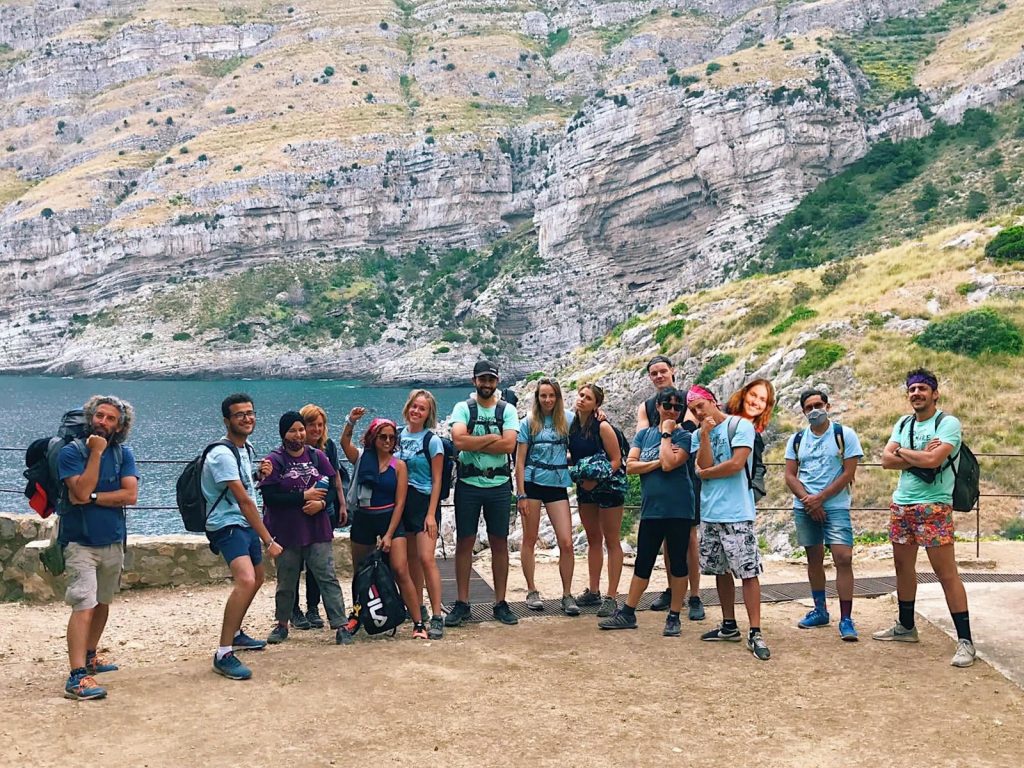
It’s 2nd of june- our first working day and, what a coincidence, Elza’s birthday. Ciao, Mimi, ciao Gianna, ciao Elza- happy birthday, and we are ready to go. On our way down the hill, we had a little gathering at Salvatore’s house to enjoy his special lemon coffee and continue our way down to the bay. It’s just the morning, but the place was already a little bit crowded with people. We didn’t know for sure what to do and how, but we did everything in our best possible way. Preparing an info point on the land, carrying kayaks into water, doing boats monitoring and water cleaning. There are always a lot of things to do in Ieranto. Of course we are very different and so are our previous experiences. “On the first day of work I felt really comfortable with the activities because I’m used to this kind of environment, like hiking, kayaking, cleaning the water, but maybe i got a bit out of my comfort zone by trying to speak Italian with local people and trying to be understood by them at the same time.”- said Mafalda, but for Cristian all of the activities were new “Absolutely everything was new for me. Cleaning the beach by kayak, information in the water and on land, speaking in Italian with local people… It was quite an experience.” Gaby’s highlight of the day is just magical.. “I went swimming to see the spearfish, it was the first time I saw something like this.” So many new things, expressions and for Elza- the best place to spend a birthday, also doing things for our nature and project, most importantly all of us together.
This is not the easiest job, but it’s something that you enjoy even if you are tired. As Ali is saying, “At first I thought that the job would be difficult, but in reality I had fun going through the different tasks that we did. We began with the cleaning of the sea and the beach, at the same time we discovered the cellars and we finished by following our dear visitor – Aguglie imperiali.”
Knowing that you can jump into the water all together after a good day of work is just amazing. And even if we are tired we always find energy for celebrations. Of course we had a birthday party when we got back home. We have all of 2021 summer to grow with this place, our mentors and with each other. And we love it so far!


